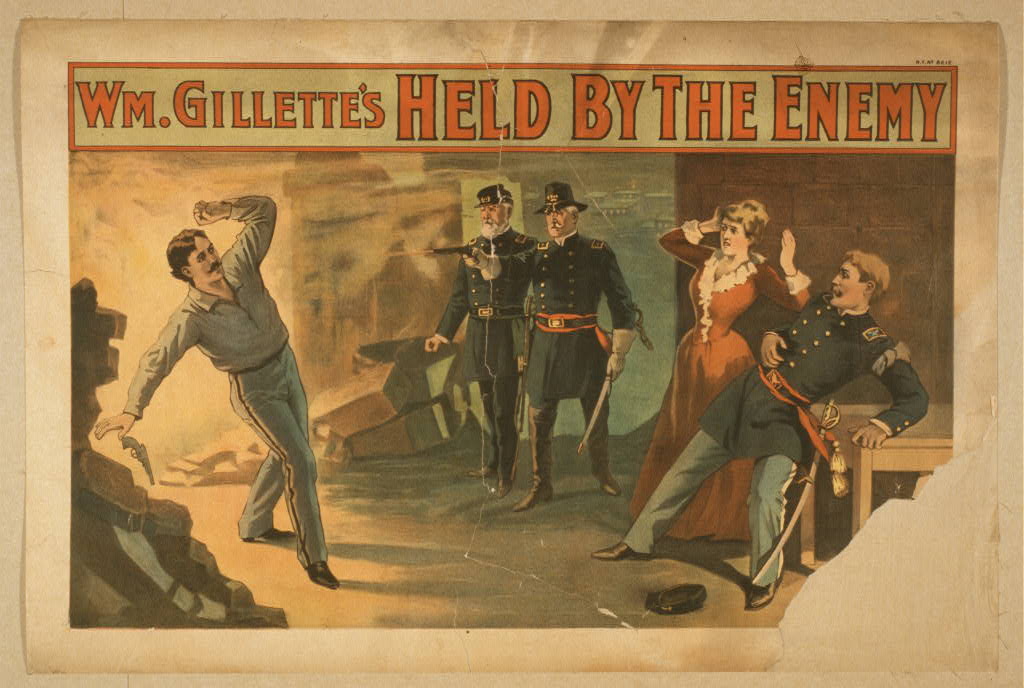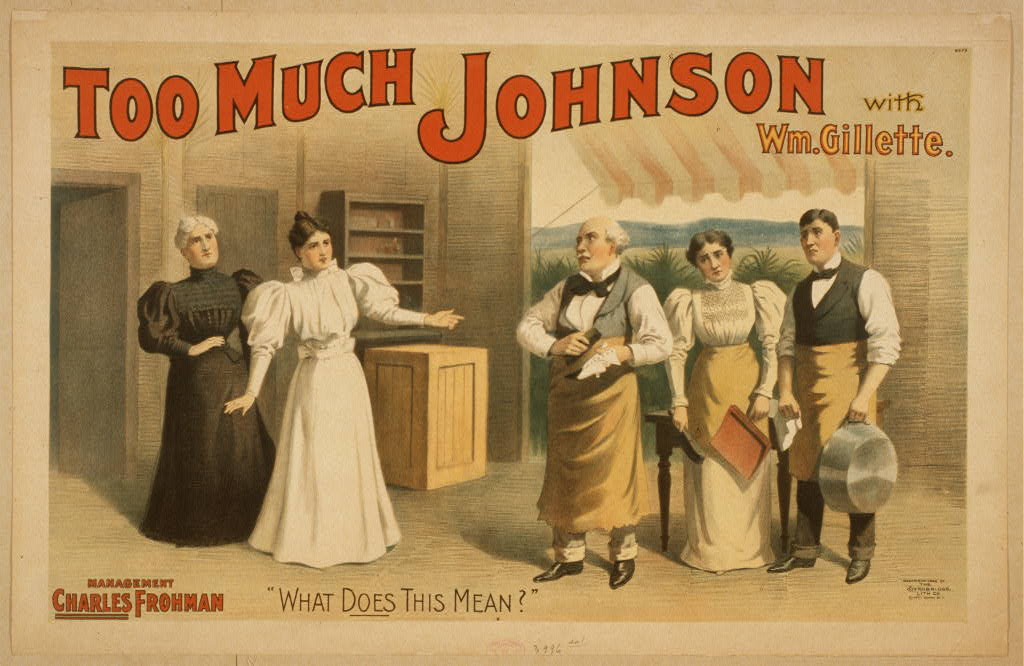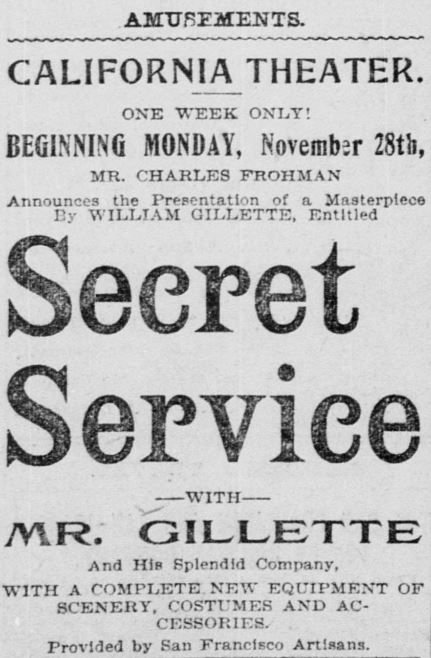 |
| www.lucywho.com |
The first actor to become famous for playing Sherlock Holmes was American William Gillette. He played Holmes more than 1300 times, in a play he wrote himself, from 1899 to 1932. Playing a role for many years was not unusual in the American theater of that time. No one knows how many times Joseph Jefferson played Rip Van Winkle between 1859 and his death in 1905. James O'Neill, father of playwright Eugene, played Edmond Dantès, The Count of Monte Cristo, more than 6000 times between 1875 and 1920. In 1896, Jefferson appeared in a series of scenes from Rip Van Winkle for the American Mutoscope and Biograph Company. At least one is available on YouTube. In 1912, James O'Neill played in a film version of Monte Cristo for Famous Players, a predecessor of Paramount. I understand it survives as a paper copyright print. In 1916, Gillette appeared in a feature film version of Sherlock Holmes for Essanay. Sadly, this film is lost. (See the 01-October-2014 update below.)
 |
| Library of Congress (POS - TH - 1898 .H44, no. 2 (C size) <P&P> [P&P]) |
 |
| Library of Congress (POS - TH - 1895 .T66, no. 1 (C size) <P&P> [P&P] ) |
 |
| Library of Congress (LC-USZC4-7243 (color film copy transparency) LC-USZ6-507 ) |
Author Arthur Conan Doyle had killed Sherlock Holmes in 1893, but, needing money, wrote a play about the character. It was not a very good play, but Conan Doyle's agent sent it to Charles Frohman, who suggested that Gillette could write a new adaption. Conan Doyle agreed, but insisted that there should be no love interest for Sherlock Holmes. Gillette sat down and read the stories and novels, which he had not read before. Gillette worked on the play while touring in Secret Service. He exchanged telegrams with Conan Doyle to get clarification. One telegram said: "May I marry Holmes?" Conan Doyle's reply said: "You may marry him, or murder or do what you like with him."[
 |
| San Francisco Call, 22-November-1898. |
The tour reached San Francisco in November, 1898. Secret Service opened in the Baldwin Theater, which was part of the Baldwin Hotel. "... with William Gillette and identically the same splendid cast seen during the triumphs in New York and London." Joaquin Miller liked to call himself "The Poet of the Sierras" and "The Byron of the Rockies." He visited the Yukon Gold Rush in 1897 and had two toes amputated because of frostbite.
 |
| The Industries of San Francisco by Frederick J Hackett. 1884. |
Gillette stayed across the street and down a few blocks at San Francisco's premiere hotel, the Palace. Gillette's secretary, William Postance, stayed at the Baldwin, keeping the manuscript of the play in his room. The Baldwin Hotel caught fire early in the morning of 23-November-1898. Postance escaped, but could not save the manuscript. At 3:30 in the morning, Postance made his way down the street and knocked on Gillette's door at the Palace. Gillette asked "Is this hotel on fire?" Postance said it was not. Gillette said "Well, come and tell me about it in the morning," and went back to bed.
 |
| San Francisco Call, 27-November-1898. |
 |
| Library of Congress (LC-USZC2-1459 (color film copy slide) LC-USZ6-497) |
 |
| The Little Fellow, Peter Cotes and Thelma Niklaus, 1951 |
In the 1901 London production, Billy the pageboy was played by a young man named Charles Chaplin. In his My Autobiography, Chaplin spoke highly of Gillette and Marie Doro, who played Alice Faulkner.
Gillette revived many of his plays over the years, but Sherlock Holmes was always in demand.
Producer Charles Frohman died in the sinking of the RMS Lusitania, which was torpedoed by German submarine U-20 on 07-May-1915. He had a bad leg so he could not get into a lifeboat. He helped tie life vests to baskets containing babies who had been left in the nursery. He joined hands with a group of people on the deck and waited for the ship to sink. His last words, according to the only member of the group who survived, were adapted from Peter Pan, which he had produced: "Why fear death? It is the most beautiful adventure that life gives us."
 |
| Moving Picture World, 01-April-1916 |
 |
| Moving Picture World, 07-October-1916 |
The film was directed by Arthur Berthelet. He directed other movies, but I have never heard of any of them. Arthur Fielding played Doctor Watson. He made a few silents, then later had a long career playing small parts in talkies. Marjorie Kay played Alice Faulkner. Sherlock Holmes is her only credit in the Internet Movie Database.
 |
| Moving Picture World, 21-October-1916 |
 |
| Bisbee, Arizona Daily Review, 24-December-1916 |
 |
| What's On the Air, December, 1930 |
There is a surviving recording of William Gillette's voice as he played Sherlock Holmes. It was made in 1934 when Gillette was 81 years old. G Robert Vincent made it for his private collection of spoken word recordings. FC Packard, a Harvard professor, played Doctor Watson. I don't know who played Alice Faulkner. The recording is available in two parts on YouTube.
Gillette played Holmes more than 1300 times. He retired several times, after long farewell tours, and then made triumphant returns. His last farewell tour ran from 1929 to 1932. William Gillette died in Hartford, Connecticut in 1937.
Gillette's home now stands in Gillette Castle State Park. Gillette had a miniature steam railroad that ran around his estate. Speaking as a fellow railfan, I am jealous. Here is a clip from a 1927 Fox Movietone newsreel featuring Gillette and his train. Note that the title says he was "retired from the stage":
William Gillette's play Sherlock Holmes served as the basis for other film adaptions. I wonder if his version is lost because later producers tried to eliminate the 1916 movie so an unscrupulous distributor would not rerelease it.
The film was thought to be lost for many years. Dedicated restorers put it back together from thousands of separate shots, often in multiple takes, that had been cut up and put together out of order, probably for tinting. I have seen it, but I must admit that I found it slow.
 |
| New Movie, March, 1930 |
In 1929, Clive Brook became the first actor to play Holmes in a talkie, The Return of Sherlock Holmes. Brook played Holmes again in 1930 in a sketch in the revue Paramount on Parade and in 1932, in Sherlock Holmes, adapted from Gillette's play. Reginald Owen played Doctor Watson. Miriam Jordan was Alice Faulkner. Ernest Torrance was Professor Moriarity. The photo, from the March, 1930 New Movie, shows William Powell as Philo Vance and Clive Brook as Holmes in Paramount on Parade.
 |
| www.listal.com |
Rathbone and Bruce made 12 more movies with lower budgets at Universal, and played Holmes and Watson on the radio. Rathbone felt that becoming so identified as Holmes hurt his career.
In 1981, a television series called Standing Room Only did an adaption of the play with Frank Langella as Sherlock Holmes.
William Gillette was not the first person to play Sherlock Holmes on the stage, but he has influenced everyone who played the part on stage, film, radio and television since he wrote the play and played the part.
So where did I find the title of this post? On 25-September-1938, The Mercury Theatre on the Air on CBS radio performed a version of Gillette's play, adapted by Orson Welles, who also played Holmes. Some people said he did an excellent imitation of Gillette. Others said Welles sounded bored. Search the web and you can find the episode and make up your own mind. In his introduction to the episode, Welles said "It is too little to say that William Gillette resembled Sherlock Holmes. Sherlock Holmes looks exactly like William Gillette."
This post is part of Sleuthathon, a Blogathon of Gumshoes, hosted by Fritzi at Movies Silently. Thank you to Fritzi for all the hard work. Thank you to everyone who visited and I encourage you to read as many posts as you can.
================================================
Update 01-October-2014.
The San Francisco Silent Film Festival announced that William Gillette's Sherlock Holmes is no longer a lost film. A print has turned up at the Cinémathèque Française. The Cinémathèque and the Festival are working together on a restoration. I'm excited.



This comment has been removed by the author.
ReplyDeleteAnother fabulous post! Interesting to read about the real reasons why a curved stem pipe was used.
ReplyDeleteI completely agree with you about the 1922 version. It really could have been more, especially considering the caliber of talent involved.
I was able to see the 1929 Clive Brook Holmes at Cinecon. While I enjoyed Brook's humorous delivery, the rest of the story landed with a thud. Moriarty even forgot his lines in several passages!
In any case, thanks for providing all the Holmesian background information, quite fascinating.
Thank you for the kind words, Fritzi. I enjoyed digging around for the information. I'm looking forward to your post on the 1922 version.
ReplyDeleteYou can suggest corrections at imdb
ReplyDeleteI can't help but think that every Holmes we have known was, whether they know it or not, influenced by William Gillette. He is as much a part of the Holmes we all love as is Conan Doyle.
ReplyDeleteYour article went superbly with my pot of tea. Thanks!
Thank you, Caftan Woman. I'm happy to go with a good pot of tea.
ReplyDeleteDJN -- That is a good point about imdb. I know people who have had mixed results trying to get things corrected, but it is worth a try.
ReplyDeleteBy Jove - he sure does look like Sherlock! I really enjoyed your post about Mr. Gillette. I visited his home (called Gillette's Castle) in Connecticut and it was, indeed, a castle fit for an actor/master sleuth!
ReplyDeleteThank you, FlickChick. I would love to visit Gillette's home. I'm glad you enjoyed the post. I had a great time writing it.
ReplyDeleteFascinating history of the Sherlock Holmes character! I like that you posted this – I like anything that can help me more of a smarty pants.
ReplyDeleteThank you for the kind words, Silver Screenings. I've always had fun being a smarty pants.
ReplyDeleteWow, lots of great, interesting detail about Gillette and his Holmes interpretation. Great job! Thank you for including the audio clips. As a Sherlock Holmes fan of long standing, I was aware of Gillette's fame for his portrayal, but knew little about the man - appreciated all the background info. Glad you included that haunting vignette about producer Charles Frohman as well.
ReplyDeleteYou're welcome, Jeff. I'm glad you found it interesting. I enjoyed hearing the sound clips, too. I came across that bit about Charles Frohman on the Lusitania and I couldn't leave it out.
ReplyDeleteSuch a fascinating post. I've read a lot of the original novels but had no idea Conan Doyle had also penned a play, and that it came with such a history. The earliest Sherlock on screen adaptation I've seen is the 1929 Brook version. I certainly look forward to exploring this earlier era in more depth.
ReplyDeleteThank you for such an insightful and informed post!
What a great, great post! It's everything you need to know about Sherlock Homes' figure! I heard of Gillette while reading Fritzi's post. The Chaplin connection is very interesting. Congratulations on such an elusive piece.
ReplyDeleteThanks for the comment.
Greetings!
girlsdofilm: Thank you, I'm glad you enjoyed. Not only did Conan Doyle write the earlier unsuccessful play, he later wrote an adaption of The Speckled Band which did well in the UK but flopped in the US:
ReplyDeletehttp://cablecarguy.blogspot.com/2013/10/the-speckled-band-october-21-2013.html
Lê: Thank you for the kind words. I think the first time I heard of Gillette was when I read Chaplin's autobiography.
Absolutely Fascinating! I love discovering new tidbits and facts - and you have revealed so much for me to digest here. In wondrous detail! I honestly knew very little on Gillette prior to reading your article. What an interesting life and long career! I am a Sherlock fan but only familiar with Rathbone, Downey Jr., and Cumberbatch. (Plus ACD's books of course...) thanks for the wonderful read!
ReplyDeleteIrish Jayhawk - I'm glad you got something out of it. You might look for movies and tv shows with Arthur Wontner and Jeremy Brett. I'm sure you'll enjoy the Bretts and the Wontners have historic interest. And he looked a bit like Gillette.
ReplyDeleteThese images are fascinating, and really put you in that time and place. And so interesting learning about Gillette's history. Loved the fire comment. It seemed so Holmes like:)
ReplyDeleteLeah
Thank you, Leah. I'm glad you enjoyed it. I agree that Gillette's comment on the fire does sound Holmes-like.
ReplyDelete